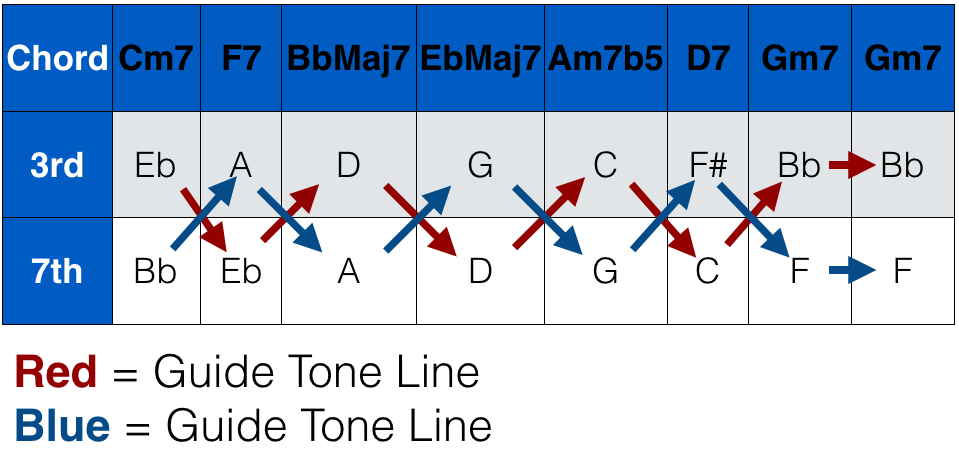Just Another Top 3 List
Improvisation is one of the core elements of Jazz. But if you’re still relatively new to improvisation you may not know where to start or how to practice. After all, how can you practice being spontaneous? Well, there are actually a number of exercises which, in my experience, can significantly improve your soloing ability. Each of these exercises is designed to help you build and improve one particular aspect of improvisation. So that, if you master all three exercises, you’ll be well on your way to putting together an interesting and sophisticated solo. So let’s get into it.
First, pick a particular song/progression that you are learning (I would suggest a song with lots of ii-V7-I’s) and practice the following exercises over it.
Jazz Improvisation Exercises
1. Melodic Continuity
This exercise is designed to force you to learn how to think quickly. All you need to do is improvise continuously your chord progression. The only rule is that you are not allowed to stop. It doesn’t matter what you play (the Major scale, a Blues scale, the Chromatic scale, etc.), you just have to keep playing. To begin with play continuously using swung eighth notes, and when this gets too easy you can try soloing continuously with triplets.
This is a fantastic exercise because it forces you to think quickly. You don’t have time to stop and think about what to play next, you just have to keep pushing through. You have to think quickly about what scales you can use, what chord you’re up to in the progression, what fingering to use, what ideas and techniques to use, etc.. And if you make a mistake, who cares, just keep on going. All of these things are incredibly important when improvising. Indeed, thinking quickly enough is probably hardest part of improvising.
Now, as you keep practicing this way for a while you’ll soon find a few hacks or shortcuts that make it easier. Repeating a phrase is one. If you’re struggling to keep up, just keep repeating the same few notes over and over again. Chromatic runs are another. Again, if you’re struggling, just play a chromatic run.
2. Guide Tone Targeting
This exercise is design to force you to follow the chord progression and resolve your phrases strongly. In this exercise you play a short phrase, pause, then play another phrase, pause, then another phrase, and so on. But the catch is that every single phrase has to end on a Guide Tone – the 3rd or 7th of the chord that you’re currently on. So, for example, if I’m playing over an F7 I would have to end my phrase on aa A or E♭. Finishing on a Guide Tone means you always resolve the phrase on a strong note, because you’re really just duplicating one of the notes in the harmony.
This is a brilliant exercise because, again, you are forced to know exactly where you are at any point in time. What chord you’re currently on and what chord comes next. Indeed, you have to think ahead a bar or two. If you start a short phrase on bar one, it’s likely to finish in bar two, so you have to know what the chord in the next bar is – and thus what the Guide Tones of that chord are. And you need to gradually direct your phrase towards one of those Guide Tones. And if you are feeling more adventurous, you can target the natural 9th of each chord instead of the 3rd or 7th, and that’ll sound really jazzy.
Also note that chord progressions also often create Guide Tone Lines that you can more easily track while improvising. Simply play phrases around the Guide Tone Line, and return to it each time you want to finish a phrase. See below for an example of a chord progression that creates two smooth Guide Tone Lines. Notice how each Guide Tone line simply stays the same or descends by one step with each chord change.

3. Repetition & Transformation
This exercise is design to force you to link your phrases together logically. In this exercise you play a phrase, any phrase, then you repeat that exact same phrase but you have to change one thing. It can be anything. You can change one note, you can change the rhythm, you could slow it down or speed it up, you could transpose the phrase, you could play it backwards/invert it, you could add ornamentals to it – right, anything you want. Then play a different phrase, and repeat it but with one thing changed (transformed). And so on. And when you’re comfortable with this, you can repeat the same phrase 3 or 4 or 20 times, each time changing one thing. This is a technique called motivic development – where you create a motif and then develop it – and is really really important and widely used in jazz.
Putting It All Together
And that’s it. If you can master each of these exercises, over a number of different songs and chord progressions, you’ll be able to think fast enough, follow the chord progression and resolve each phrase strongly, and link your phrases together logically. Being able to do these three things simultaneously and well will allow you to create a really professional, sophisticated and decent solo. For an example of each of the above exercises check out the below video.